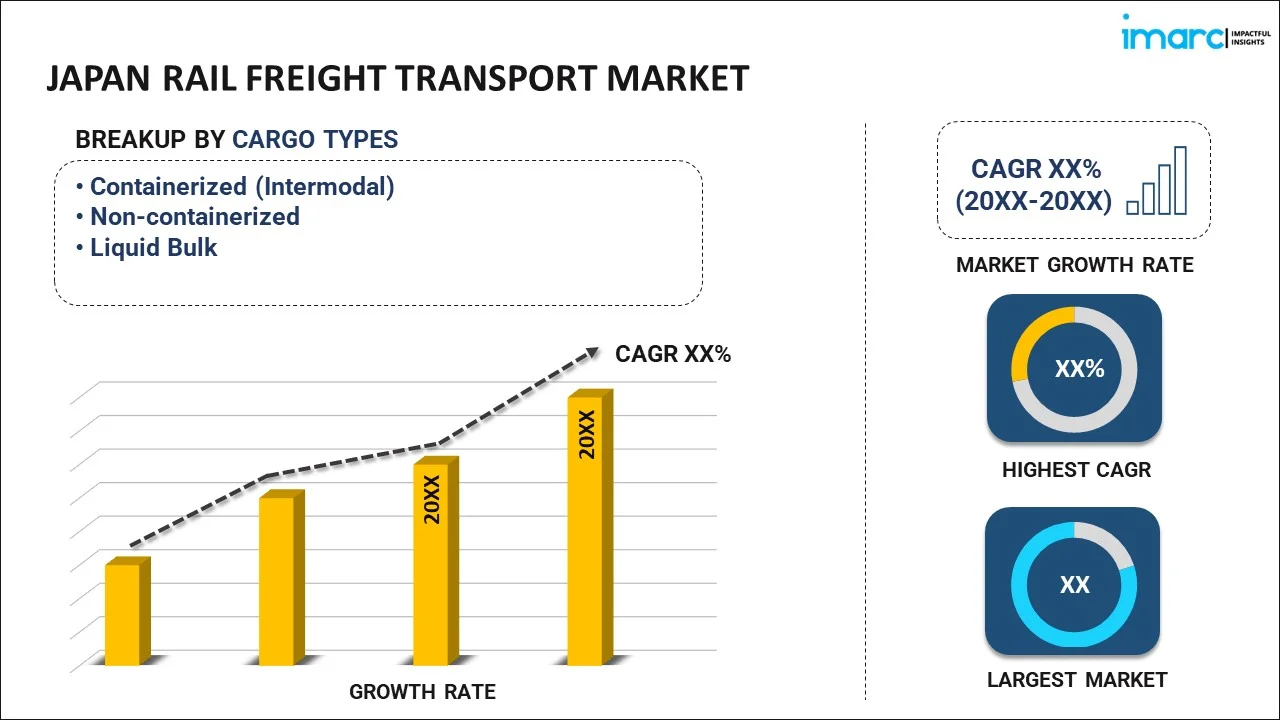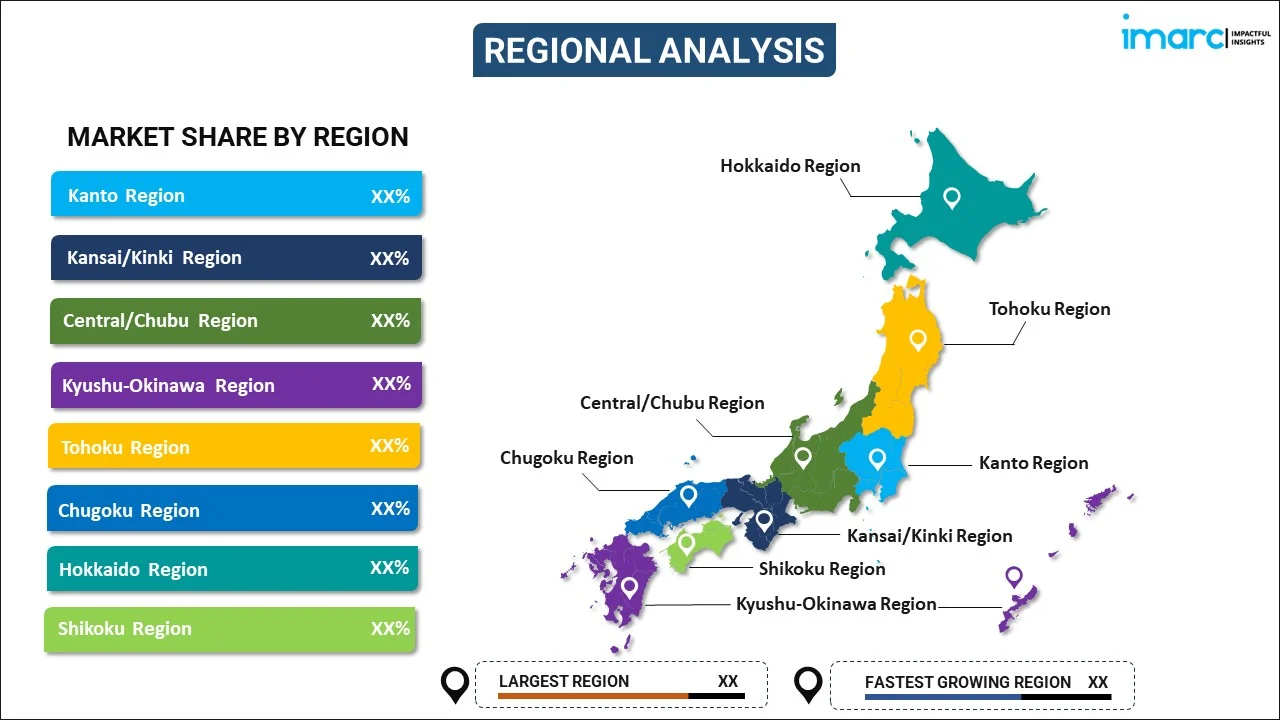
Japan Rail Freight Transport Market Report by Cargo Type (Containerized (Intermodal), Non-containerized, Liquid Bulk), Service Type (Transportation, Services Allied to Transportation), and Region 2025-2033
Market Overview:
Japan rail freight transport market size reached 16.6 Billion Tonne Km in 2024. Looking forward, IMARC Group expects the market to reach 21.5 Billion Tonne Km by 2033, exhibiting a growth rate (CAGR) of 2.7% during 2025-2033. The escalating innovations in rail technology, such as more fuel-efficient locomotives, advanced tracking and monitoring systems, automation, etc., which can improve the efficiency, safety, and competitiveness of rail freight transport are primarily driving the market.
|
Report Attribute
|
Key Statistics
|
|---|---|
|
Base Year
|
2024 |
|
Forecast Years
|
2025-2033
|
|
Historical Years
|
2019-2024
|
| Market Size in 2024 | 16.6 Billion Tonne Km |
| Market Forecast in 2033 | 21.5 Billion Tonne Km |
| Market Growth Rate (2025-2033) | 2.7% |
Rail freight transport, also known as rail cargo or rail shipping, is a mode of transporting goods and commodities using specially designed trains on dedicated rail tracks. It plays a vital role in the regional transportation industry, offering a cost-effective and efficient means of moving huge quantities of goods over long distances. Rail freight transport involves the loading of goods into freight cars, which come in various types to accommodate different cargo types, such as containers, bulk materials, and liquid tankers. These freight cars are then hauled by locomotives along established rail networks. Advantages of rail freight transport include its ability to carry heavy and bulky loads, lower carbon emissions compared to road transport, and reduced traffic congestion. It is particularly well-suited for long-haul transportation of raw materials, finished products, and bulk commodities, such as coal, grain, and chemicals. Despite facing competition from other modes of transportation, rail freight remains a crucial component of the global supply chain, supporting industries like manufacturing, agriculture, and energy production. It continues to evolve with technological advancements to improve efficiency and sustainability.
Japan Rail Freight Transport Market Trends:
The rail freight transport market in Japan is experiencing significant growth, primarily driven by several key factors. To begin with, the growing demand for sustainable transportation solutions has played a pivotal role. As concerns about carbon emissions and environmental sustainability continue to mount, businesses and governments alike are turning to rail as a cleaner, more eco-friendly alternative to long-haul trucking. Additionally, the ever-expanding e-commerce sector has contributed to the rise in rail freight, with the need for efficient and cost-effective logistics solutions becoming increasingly critical. Furthermore, the ongoing expansion of regional trade has boosted rail freight's importance as a reliable and cost-efficient means of moving goods across vast distances. Apart from this, infrastructure investments have played a crucial role in supporting the rail freight market's growth. Furthermore, the integration of digital technologies and data analytics, which enhance the efficiency and transparency of rail freight operations, making it more competitive and appealing to businesses, is expected to drive the market in Japan.
Japan Rail Freight Transport Market Segmentation:
IMARC Group provides an analysis of the key trends in each segment of the market, along with forecasts at the country level for 2025-2033. Our report has categorized the market based on cargo type and service type.
Cargo Type Insights:

- Containerized (Intermodal)
- Non-containerized
- Liquid Bulk
The report has provided a detailed breakup and analysis of the market based on the cargo type. This includes containerized (intermodal), non-containerized, and liquid bulk.
Service Type Insights:
- Transportation
- Services Allied to Transportation
A detailed breakup and analysis of the market based on the service type have also been provided in the report. This includes transportation and services allied to transportation.
Regional Insights:

- Kanto Region
- Kansai/Kinki Region
- Central/ Chubu Region
- Kyushu-Okinawa Region
- Tohoku Region
- Chugoku Region
- Hokkaido Region
- Shikoku Region
The report has also provided a comprehensive analysis of all the major regional markets, which include Kanto Region, Kansai/Kinki Region, Central/ Chubu Region, Kyushu-Okinawa Region, Tohoku Region, Chugoku Region, Hokkaido Region, and Shikoku Region.
Competitive Landscape:
The market research report has also provided a comprehensive analysis of the competitive landscape in the market. Competitive analysis such as market structure, key player positioning, top winning strategies, competitive dashboard, and company evaluation quadrant has been covered in the report. Also, detailed profiles of all major companies have been provided.
Japan Rail Freight Transport Market Report Coverage:
| Report Features | Details |
|---|---|
| Base Year of the Analysis | 2024 |
| Historical Period | 2019-2024 |
| Forecast Period | 2025-2033 |
| Units | Billion Tonne Km |
| Scope of the Report | Exploration of Historical Trends and Market Outlook, Industry Catalysts and Challenges, Segment-Wise Historical and Future Market Assessment:
|
| Cargo Types Covered | Containerized (Intermodal), Non-containerized, Liquid Bulk |
| Service Types Covered | Transportation, Services Allied to Transportation |
| Regions Covered | Kanto Region, Kansai/Kinki Region, Central/ Chubu Region, Kyushu-Okinawa Region, Tohoku Region, Chugoku Region, Hokkaido Region, Shikoku Region |
| Customization Scope | 10% Free Customization |
| Post-Sale Analyst Support | 10-12 Weeks |
| Delivery Format | PDF and Excel through Email (We can also provide the editable version of the report in PPT/Word format on special request) |
Key Questions Answered in This Report:
- How has the Japan rail freight transport market performed so far and how will it perform in the coming years?
- What has been the impact of COVID-19 on the Japan rail freight transport market?
- What is the breakup of the Japan rail freight transport market on the basis of cargo type?
- What is the breakup of the Japan rail freight transport market on the basis of service type?
- What are the various stages in the value chain of the Japan rail freight transport market?
- What are the key driving factors and challenges in the Japan rail freight transport?
- What is the structure of the Japan rail freight transport market and who are the key players?
- What is the degree of competition in the Japan rail freight transport market?
Key Benefits for Stakeholders:
- IMARC’s industry report offers a comprehensive quantitative analysis of various market segments, historical and current market trends, market forecasts, and dynamics of the Japan rail freight transport market from 2019-2033.
- The research report provides the latest information on the market drivers, challenges, and opportunities in the Japan rail freight transport market.
- Porter's five forces analysis assist stakeholders in assessing the impact of new entrants, competitive rivalry, supplier power, buyer power, and the threat of substitution. It helps stakeholders to analyze the level of competition within the Japan rail freight transport industry and its attractiveness.
- Competitive landscape allows stakeholders to understand their competitive environment and provides an insight into the current positions of key players in the market.
Need more help?
- Speak to our experienced analysts for insights on the current market scenarios.
- Include additional segments and countries to customize the report as per your requirement.
- Gain an unparalleled competitive advantage in your domain by understanding how to utilize the report and positively impacting your operations and revenue.
- For further assistance, please connect with our analysts.
 Inquire Before Buying
Inquire Before Buying
 Speak to an Analyst
Speak to an Analyst
 Request Brochure
Request Brochure
 Request Customization
Request Customization




.webp)




.webp)












